英语翻译概论
翻译概论期末总结
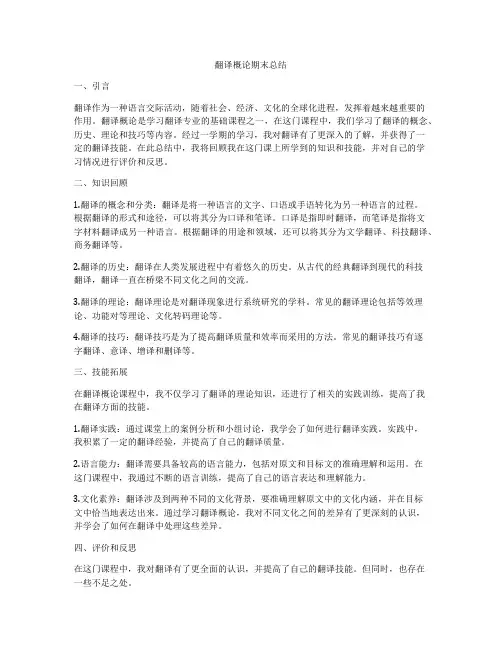
翻译概论期末总结一、引言翻译作为一种语言交际活动,随着社会、经济、文化的全球化进程,发挥着越来越重要的作用。
翻译概论是学习翻译专业的基础课程之一,在这门课程中,我们学习了翻译的概念、历史、理论和技巧等内容。
经过一学期的学习,我对翻译有了更深入的了解,并获得了一定的翻译技能。
在此总结中,我将回顾我在这门课上所学到的知识和技能,并对自己的学习情况进行评价和反思。
二、知识回顾1.翻译的概念和分类:翻译是将一种语言的文字、口语或手语转化为另一种语言的过程。
根据翻译的形式和途径,可以将其分为口译和笔译。
口译是指即时翻译,而笔译是指将文字材料翻译成另一种语言。
根据翻译的用途和领域,还可以将其分为文学翻译、科技翻译、商务翻译等。
2.翻译的历史:翻译在人类发展进程中有着悠久的历史。
从古代的经典翻译到现代的科技翻译,翻译一直在桥梁不同文化之间的交流。
3.翻译的理论:翻译理论是对翻译现象进行系统研究的学科。
常见的翻译理论包括等效理论、功能对等理论、文化转码理论等。
4.翻译的技巧:翻译技巧是为了提高翻译质量和效率而采用的方法。
常见的翻译技巧有逐字翻译、意译、增译和删译等。
三、技能拓展在翻译概论课程中,我不仅学习了翻译的理论知识,还进行了相关的实践训练,提高了我在翻译方面的技能。
1.翻译实践:通过课堂上的案例分析和小组讨论,我学会了如何进行翻译实践。
实践中,我积累了一定的翻译经验,并提高了自己的翻译质量。
2.语言能力:翻译需要具备较高的语言能力,包括对原文和目标文的准确理解和运用。
在这门课程中,我通过不断的语言训练,提高了自己的语言表达和理解能力。
3.文化素养:翻译涉及到两种不同的文化背景,要准确理解原文中的文化内涵,并在目标文中恰当地表达出来。
通过学习翻译概论,我对不同文化之间的差异有了更深刻的认识,并学会了如何在翻译中处理这些差异。
四、评价和反思在这门课程中,我对翻译有了更全面的认识,并提高了自己的翻译技能。
但同时,也存在一些不足之处。
英语翻译--汉译英1.汉译英概论
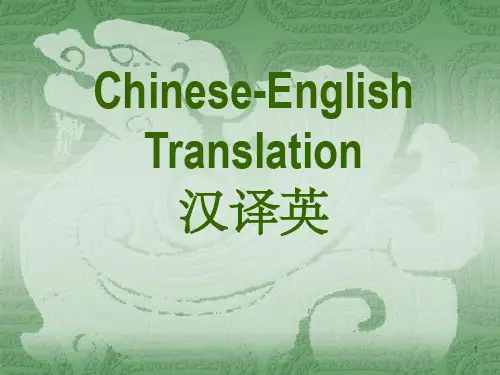
She is used to holding up an umbrella.
Let her go in front and flash a torch 让她在前面给我们打手电。 for us.
我们必须打起精神来工作 We must raise our spirits to work and
I played center on the basketball
我在篮球队打中锋。 team.
We should spray insecticide
upon plants.
我们应给植物打农药。 I can tell you nobody should try
any lawsuit.
咱告诉大家这官司打 不得呀 !
在阅读中了解和熟悉不同风格的英语的行文 特点。
.
16
Thank you!
.
17
和学习。
study.
He called her at home.
他打电话到她家里。
He cabled me directly.
他直接打电报来的。
Write a letter of introduction for me.
请你给我打介绍信。
.
12
打一盆水来!
Fetch a basin of water!
Chinese-English
Translation 汉译英
.
1
汉英差异
汉语重语义,英语重结构 汉语多短句,英语多长句 汉语多分句,英语多从句 汉语多名词,英语多代词 汉语多主动,英语多被动 汉语多重复,英语多变化 汉语多具体,英语多抽象 汉语多推理,英语多引申 汉语多补充,英语多省略 汉语多后中心,英语多前中心
翻译概论翻译的目的之交际
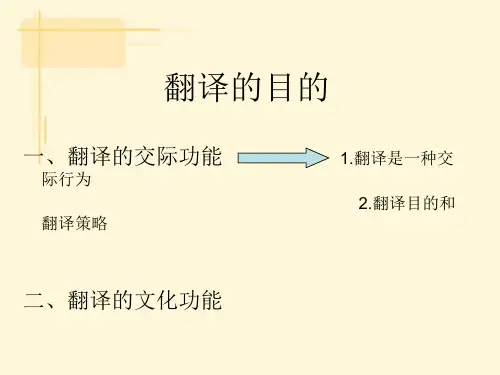
1. 标题改写
• 标题是新闻的眼睛,其功能是“提炼内容、美化版面和吸引读者” (郜书锴)。好的新闻标题常常具有简约、醒目、概括、风趣的特点 (刘宓庆)。标题翻译的好坏,直接影响着整篇新闻的交际效果和读 者的兴趣。 (1) 苏州纺织业——重围中求生 Suzhou‟s Textile Industry: Besieged, yet Fighting Hard 对比例(1)的原文和译文,最明显的是中文的破折号改成了冒号,这是 符合英文标题的习惯写法的。英文标题分成两部分,第二部分对第一 部分构成修饰或主谓关系时,通常用冒号加以隔开。 (2) 苏州迎来轻轨时代 Suzhou Ready to Build Its First Light Rail Line 例(2)原文是一个完整的陈述句,翻译成英文时用了省略句,这符合英 语新闻标题中大量使用动词不定式、动名词、分词等非谓语动词的惯 例。另外,此例英译文摈弃汉语中“轻轨时代”过分夸张的说法,代 之以“Build Its First Light Rail Line”,这符合英语平实的语言风格。
交际翻译法在汉英新闻翻译中的应用 ----以Suzhou Weekly为例
• 采取何种翻译方法取决于三个因素:文本类型、读者身份和翻译目的。 新闻属信息型语篇,适合用交际翻译法。以纽马克的交际翻译理论为 依据,对Suzhou Weekly中的若干汉英译例从标题改写、词汇变通和 句法重组三个方面进行了分析,以期为解决汉英新闻翻译中可能遇到 的种种问题探索切实可行的解决方案。 • [Abstract]Newmark contends that the choice of translation method is determined by three factors: type of text, nature of the readership and purpose of the translation. Accordingly, communicative translation method applies to the translation of news, which falls into the type of informative text. This paper, based on Newmark‟s communicative translation theory, explores feasible solutions to various problems likely encountered in Chinese-English news translation by analyzing the typical examples taken from Suzhou Weekly in terms of three aspects: title rewriting, lexical change and syntactic restructuring.
英语翻译概论
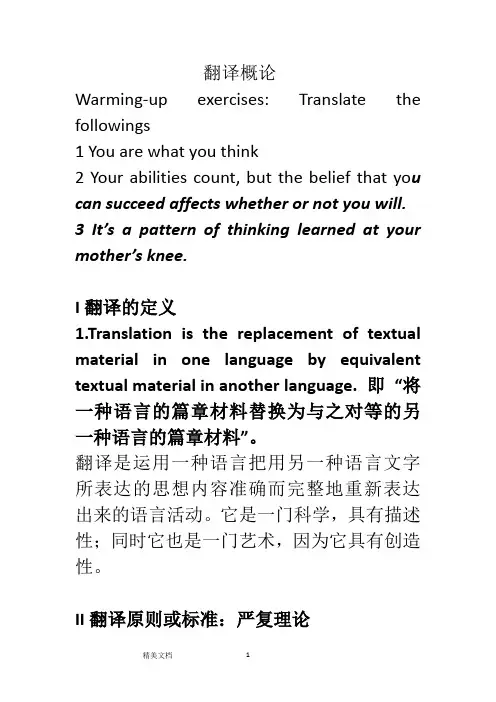
翻译概论Warming-up exercises: Translate the followings1 You are what you think2 Your abilities count, but the belief that yo u can succeed affects whether or not you will.3 It’s a pattern of thinking learned at your mother’s knee.I翻译的定义1.Translation is the replacement of textual material in one language by equivalent textual material in another language. 即“将一种语言的篇章材料替换为与之对等的另一种语言的篇章材料”。
翻译是运用一种语言把用另一种语言文字所表达的思想内容准确而完整地重新表达出来的语言活动。
它是一门科学,具有描述性;同时它也是一门艺术,因为它具有创造性。
II翻译原则或标准:严复理论1 信(truthfulness/faithfulness):忠实原文(对原文的思想不歪曲也不要任意增减;对原文的风格不随意改动,即粗糙的不译成高雅,口语体不译成书面体)2 达(expressiveness):语言通顺畅达(译文应该按照译语的语法和习惯来遣词造句;译文避免生搬硬套,应该通顺流畅)Eg . John can be relied on. He eats no fish and plays the game.约翰值得信赖。
他忠诚而正直(守规矩)。
3 雅(elegance):文字古雅/ 切(closeness)总之,做英译汉时,按中国人的说话思维方式,把内容用通俗的汉语顺畅地表达出来;反之亦然。
1. It therefore becomes more and more important that, if students are not to waste their opportunities, there will have to have much more detailed information about courses and more advice.2. People were afraid to leave their houses, for although the police had been ordered to stand by in case of emergency, they were justas confused and helpless as everybody else. 1. 因此,如果要使学生充分利用他们(上大学)的机会,就得为他们提供大量关于课程的更为详细的信息,作更多的指导。
中医英语翻译概论
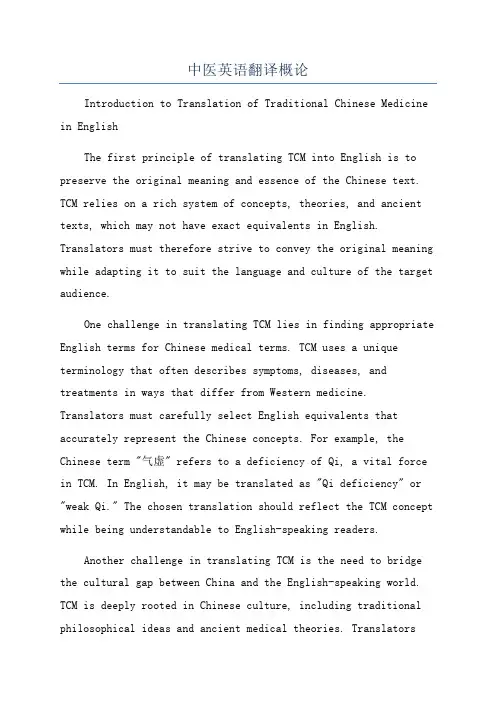
中医英语翻译概论Introduction to Translation of Traditional Chinese Medicine in EnglishThe first principle of translating TCM into English is to preserve the original meaning and essence of the Chinese text. TCM relies on a rich system of concepts, theories, and ancient texts, which may not have exact equivalents in English. Translators must therefore strive to convey the original meaning while adapting it to suit the language and culture of the target audience.One challenge in translating TCM lies in finding appropriate English terms for Chinese medical terms. TCM uses a unique terminology that often describes symptoms, diseases, and treatments in ways that differ from Western medicine. Translators must carefully select English equivalents that accurately represent the Chinese concepts. For example, the Chinese term "气虚" refers to a deficiency of Qi, a vital force in TCM. In English, it may be translated as "Qi deficiency" or "weak Qi." The chosen translation should reflect the TCM concept while being understandable to English-speaking readers.Another challenge in translating TCM is the need to bridge the cultural gap between China and the English-speaking world. TCM is deeply rooted in Chinese culture, including traditional philosophical ideas and ancient medical theories. Translatorsmust find ways to convey these cultural nuances to English readers without overwhelming them with unfamiliar concepts. This may require adapting the translation to make it more accessible to the target audience. For example, the concept of "yin" and "yang," which describes opposing yet interconnected forces in TCM, can be explained in English by using terms like "balance" and "harmony."Translating TCM also involves conveying the effectiveness and safety of TCM treatments to English-speaking readers. TCM has its own empirical evidence and clinical experience, which may not align with the standards and conventions of Western medicine. Translators must find ways to present this evidence in a manner that is understandable and acceptable to English-speaking readers. This may involve providing additional explanations, citing research studies, or using terminology that is familiar to both TCM and Western medicine.In summary, translating TCM into English requirestranslators to preserve the original meaning and essence of the Chinese text while finding appropriate English equivalents for Chinese medical terms. It also involves bridging the cultural gap and conveying the effectiveness and safety of TCM treatments to English-speaking readers. By understanding the principles and challenges of translating TCM, translators can effectively convey the richness and depth of this ancient medical tradition to the global audience.。
翻译概论Chapter1-2从翻译的比喻认识翻译的本质及翻译的原则
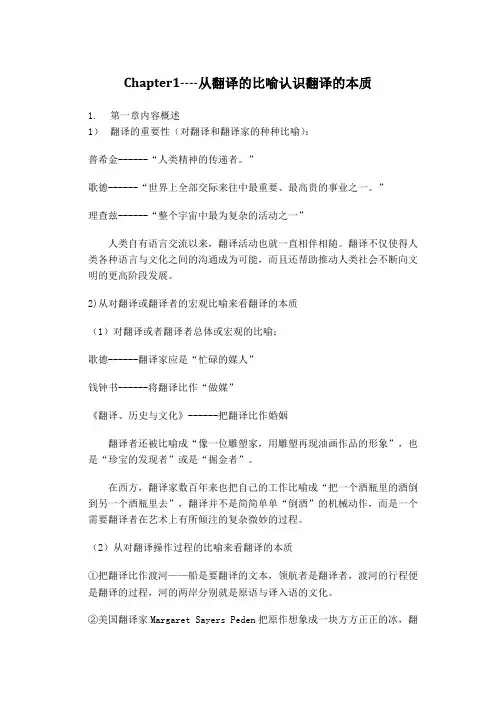
Chapter1----从翻译的比喻认识翻译的本质1.第一章内容概述1)翻译的重要性(对翻译和翻译家的种种比喻):普希金------“人类精神的传递者。
”歌德------“世界上全部交际来往中最重要、最高贵的事业之一。
”理查兹------“整个宇宙中最为复杂的活动之一”人类自有语言交流以来,翻译活动也就一直相伴相随。
翻译不仅使得人类各种语言与文化之间的沟通成为可能,而且还帮助推动人类社会不断向文明的更高阶段发展。
2)从对翻译或翻译者的宏观比喻来看翻译的本质(1)对翻译或者翻译者总体或宏观的比喻;歌德------翻译家应是“忙碌的媒人”钱钟书------将翻译比作“做媒”《翻译、历史与文化》------把翻译比作婚姻翻译者还被比喻成“像一位雕塑家,用雕塑再现油画作品的形象”,也是“珍宝的发现者”或是“掘金者”。
在西方,翻译家数百年来也把自己的工作比喻成“把一个酒瓶里的酒倒到另一个酒瓶里去”,翻译并不是简简单单“倒酒”的机械动作,而是一个需要翻译者在艺术上有所倾注的复杂微妙的过程。
(2)从对翻译操作过程的比喻来看翻译的本质①把翻译比作渡河——船是要翻译的文本,领航者是翻译者,渡河的行程便是翻译的过程,河的两岸分别就是原语与译入语的文化。
②美国翻译家Margaret Sayers Peden把原作想象成一块方方正正的冰,翻译的过程就是这块冰的熔化过程。
这个比喻借用了自然科学对物质从一种状态变成另一种状态的描述,十分生动,也颇富揭示性。
③对翻译,另一种最新的、更具揭示性的比喻是“没有舞台的演出”。
④巴西翻译家——“食人者”对翻译者或者翻译的种种比喻尽管五花八门,但都有一个明显的特征,即它们基本上都是正面的,都包含对翻译者工作的褒扬,是确实还有少数比喻表达了对翻译或翻译者的否定或批评;如“翻译即背叛者等”。
2)翻译的本质翻译是一种文化传播的工具,在国与国之间、原语文化与译入语文化之间起着桥梁和纽带的作用;翻译不仅仅是文本从一种语言向另一种语言的过渡,也是文本之间、文化之间的一种协商过程,是以翻译者为中间人进行交流和斡旋的过程;翻译不仅仅是一门涉及语符转换、意义传递的技巧或技艺,更是一项极富创造性、挑战性的活动,是“一种艺术,一种需要译者像画家、表演家”那样具有高超创作才能的艺术。
大学英语翻译概论
01
诗歌翻译三美原则:意美、音美、形美
02
Beauty in Sense, Sound, Style
许渊冲
美国 奈达 Eugene Nida: 读者反应论
01
(Receptor’s response)
02
忠实原文
03
易于理解
04
形式恰当
05
吸引读者
06
01
Equivalence
与原文作用相符(表达方面的等值)
01
02
国际译联主席Betty Cohen:Never in history have we been so indispensable to trade, culture, peace, and humanity…Just imagine one day in the world without translation…would all be mute. We are like the electricity in the wires and the water in the tap.
04
A musician / an actor
03
关于译者的比喻:
2.The purpose of translation
交流信息,克服语言障碍
01
特定文本的翻译具有其特定的目的,有其预设的读者群
04
学习其他语言的文化和文明,帮助向更高的文明发展
02
帮助经济、政治等各方面的交流和发展
03
Translatability and untranslatability (Language / Cultural Barriers) Translatability is lower when (1) the work to be translated is quite distant both in time and space; (2) its form is very much unique; (3) the content is not shared in the two cultures.
翻 译 概 论
玄奘:在一定程度上继承了慧远的“厥中” 论,指出翻译“既须求真,又须喻俗”。 梁启超评价道:“若玄奘者,则意译直译, 圆满调和,斯道之极轨也。”不过在实际 的翻译实践中,玄奘有时却推崇“五不翻” 的音译技巧。正是这种技巧指导下的译文 让鲁迅感叹“粗粗一看,简直是不能懂 的”。(鲁迅《二心集》)
明末清初时期魏象乾在《繙清说》中表达 了自己对翻译的看法。刘半农指出此文涉 及的问题和观点“多与今世译人不谋而 合”。魏氏论及的一个重要问题是“翻译 之道”即“翻译标准”: “窃惟翻译之道,至显而寓至微,至约而 寓至博,信乎千变万化、神妙莫测也。惟 其变化无穷,遂有出入失正之弊,学者不 可不审焉。夫所谓“正”者,了其意,完 其辞,顺其气,传其神,不增不减,不颠 不倒,不恃取意,而清文精练,适当其可 也。”
失之交臂
1988年辜正坤发表“翻译标准多元互补论” 一文,认为“用以指导翻译实践并判断译 作价值的具体标准不但有,而且不止一 个”。这些标准构成了翻译标准的一个多 元系统:绝对标准——最高标准——具体 标准。在这个系统里,所有标准都统一于 绝对标准,翻译的绝对标准就是“原作本 身”。由于绝对再现原作不可能,所以翻 译只能追求最高标准,即“最佳近似度”。 要判断译文是否最近似于原文就需要一些 具体的标准衡量。具体标准是由翻译的功 能、人类的审美情趣以及读者、译者的多 层次性决定的,因此翻译的具体标准不止 一个。
莱斯的学生费米尔突破了对等理论的限制,以文 本目的(skopos)为翻译过程的第一准则,发展了 功能派的主要理论:目的论(skopos theory)。目 的论是功能派翻译理论中最重要的理论。skopos 是希腊词,意思是“目的”。根据目的论,所有翻 译遵循的首要法则就是“目的法则”:翻译行为 所要达到的目的决定整个翻译行为的过程,即结 果决定方法。这个目的有三种解释:译者的目的 (如赚钱);译文的交际目的(如启迪读者);和 使用某种特殊翻译手段所要达到的目的(如为了 说明某种语言中语法结构的特殊之处而采用按其 结构直译的方法)。通常情况下,―目的”是指译文 的交际目的。
翻译概论英语
国外翻译理论三大核心概念(core concept):实质(essence),可译性(translatability),等值(equivalency)实质:早期提法,以奥格庭为代表:将符号改变为另外的符号Jakobson:Translation is an interpretation of verbal signs(semiotics 符号学) by means of some other language.”第二类,以费道罗夫和温特为代表:加上了忠实(faithfulness),全面(overall),等值(equivalency)费道罗夫:翻译是用一种语言忠实、全面地表达另一种语言表达的东西温特:翻译是将诠释我们世界某部分的说法尽可能地用等值的说法来代替。
奈达和泰伯( Nida & Taber):Translating consists in reproducing in the receptor language the the closest natural equivalent(最贴近自然的对等表达式) of the source- language message, first in terms of meaning and second in terms of style.翻译是接受语复制原语信息的最近似的自然等值物,首先是在意义方面,其次是在文体方面的等值。
第三类,以卡特福德,巴尔胡达罗夫( Barkhudarov),威尔斯为代表明确翻译对象是话语(utterance注意不同于话语权的discourse)卡特福德( Catford):Translation is “the replacement of textual material in one language by equivalent textual material in another language. ( core: textual sense)将一种语言的话语材料用另外一种语言的等值话语予以替代威尔斯:翻译是将原语话语变为尽可能等值的译语话语的过程巴尔胡达罗夫( Barkhudarov): A unit of translation is “ the smallest unit of SL which has an equivalent in TL.第四类,以什维采尔为代表,又增加了文化(culture)内容,王佐良先生(venerable Wang Zuoliang)认为:翻译工作者处理的是个别的词,面对的则是两大片文化。
医学-中医英语翻译概论
1 中医翻译概论
1.3 词义分化
– 脾虚
• asthenia of the spleen (Li) • spleen vacuity (Wiseman) • spleen deficiency (WHO draft)*
– 脾虚水泛
• hypofunction of the spleen* (Li)
TCM Translation Theory
中医英语翻译理论
1 中医翻译概论
1.1 仿造
– 翻译 SL 的無等值词汇時,用 TL 中的直接对应词 代換無等值词汇的組成部分 (词素 / 词)
– 借用英语中已有的相关單词來表达中医学特有的概 念
• 肝血
liver blood
• 血虚
blood deficiency
• 虚脹 – Flatulence due to yang-deficiency of the spleen and kidney
1 中医翻译概论
1.2 定义化 – 缺点
• 简洁变冗長,违反科技术语翻译、使用的原翻则 • 和语境难以配合 • 有碍中医术语英译迈向规范
– 简化处理
• 辨证论治 – treatment based on syndrome differentiation (Li) – identifying patterns and determining treatment
• 活血化瘀 activating blood to resolve stagnation
1 中医翻译概论
1.1 仿造
– 句子层次的翻译也能运用仿造法
• 從阴阳翻则生,逆之翻则死。 – Following (the law of) yin and yang ensures life, while violating it leads to death.
- 1、下载文档前请自行甄别文档内容的完整性,平台不提供额外的编辑、内容补充、找答案等附加服务。
- 2、"仅部分预览"的文档,不可在线预览部分如存在完整性等问题,可反馈申请退款(可完整预览的文档不适用该条件!)。
- 3、如文档侵犯您的权益,请联系客服反馈,我们会尽快为您处理(人工客服工作时间:9:00-18:30)。
翻译概论Warming-up exercises: Translate the followings1 You are what you think2 Your abilities count, but the belief that yo u can succeed affects whether or not you will.3 It’s a pattern of thinking learned at your mother’s knee.I翻译的定义1.Translation is the replacement of textual material in one language by equivalent textual material in another language. 即“将一种语言的篇章材料替换为与之对等的另一种语言的篇章材料”。
翻译是运用一种语言把用另一种语言文字所表达的思想内容准确而完整地重新表达出来的语言活动。
它是一门科学,具有描述性;同时它也是一门艺术,因为它具有创造性。
II翻译原则或标准:严复理论1 信(truthfulness/faithfulness):忠实原文(对原文的思想不歪曲也不要任意增减;对原文的风格不随意改动,即粗糙的不译成高雅,口语体不译成书面体)2 达(expressiveness):语言通顺畅达(译文应该按照译语的语法和习惯来遣词造句;译文避免生搬硬套,应该通顺流畅)Eg . John can be relied on. He eats no fish and plays the game.约翰值得信赖。
他忠诚而正直(守规矩)。
3 雅(elegance):文字古雅/ 切(closeness)总之,做英译汉时,按中国人的说话思维方式,把内容用通俗的汉语顺畅地表达出来;反之亦然。
1. It therefore becomes more and more important that, if students are not to waste their opportunities, there will have to have much more detailed information about courses and more advice.2. People were afraid to leave their houses, for although the police had been ordered to stand by in case of emergency, they were just as confused and helpless as everybody else.1. 因此,如果要使学生充分利用他们(上大学)的机会,就得为他们提供大量关于课程的更为详细的信息,作更多的指导。
这个显得越来越重要了。
2. 尽管警察已接到命令,要作好准备以应付紧急情况,但人们不敢出门,因为警察和其他人一样不知所措和无能为力。
III翻译的过程1理解阶段: 是表达的先决条件1)了解语言现象: Peter is now with his parents in Beijing; it has already three years since he was a pop singer. ...不唱流行歌已有三年了2)理解逻辑关系 You are late for the last time.你被解雇了或者不可能再迟到了.3)理解原文所涉及的事物 The elevator boys ooze(流出,渗透出) the spit andpolish of West Point cadets and in polite English remind you that you must not smoke inside their lift.开电梯的人像西点军校的学生一样衣着整洁,劲头十足。
2表达阶段:把自己对原文的理解用本族语重新表达出来。
1)充分表达 Reports of new successes keep pouring in. 捷报频传// He sold hard-to -get items.他经销紧俏商品。
2)直译和意译:能直译时不要意译; 需要直译和意译结合时,在直译的基础上意译。
a.O ne boy is a boy, two boys half a boy ,three boys no boy.意译b.S trike the iron while it is hot.直译c.J ohn was upsetting the otherchildren, so I showed him the door.直译+意译约翰一直在扰乱别的孩子,我就把他撵了出去。
形式对等翻译与动态对等翻译:前者着眼于原文,后者用最贴切而又最自然的对等语再现原语的信息The streets were completely deserted and everything stood in crumbling(坍塌)ruins.街道上空无一人(阒无人迹),到处都是断垣残壁.3)校对阶段(proofread):是理解与表达的进一步深化。
IV 翻译技巧: 1) 分清主次 2) 遣词用字 3) 词字的增添 4) 词字的省略 5) 词类及句子成分的转换 6) 结构的调整 7) 语态变化 8) 正反交替 9) 长句切分V翻译的方法或策略: 直译和意译什么是直译和意译1)直译(literal translation)(偏重于原文字句)与意译(free translation)(根据原文的大意);前者强调语言的共性,后者来自语言的差异所谓直译,就是在译文语言条件许可的时候,在译文中既能保持原文的思想内容,又尽可能保持与原文语言形式相对应的形式。
这并不是对原文逐字对译的死译,而是指在忠实原文思想内容的同时,保持原文的语言特色,即忠实地传达深层结构的同时,又能再现表层结构的风格。
例如: be armed to teeth, chain reaction, crocodile tears , win-win 这些直译出来汉语对应原文的字面意思,保留了原文的生动形象. 汉语中一些特有事物也可以按字面意思译成英语. 例如: 三教九流 (the three religions and the nine schools of thought), 四书五经(the Four Books and the Five Classics ) 一国两制(one country, two systems))意译,如果用原文语言形式相对应的译文语言形式不能忠实地传达原文的思想内容的时候,就要保持原文的思想内容,而不完全保持与原文语言想对应的语言形式。
这不是指偏离原作的含义,甚至完全脱离原作思想内容的乱译。
忠实传递深层结构的同时,不完全再现原文表层结构的风格。
例如: Don’t cross the bridge till you get to it ?船到桥头自然直。
Do you see any green in my eye ? 你觉得我幼稚可欺吗?(你以为我是好欺侮的吗?)望子成龙 (long to see one’s son succeed in life)破釜沉舟(burn one’s boats)直译和意译的相对性由于英,汉两种语言在表达方式,用法习惯等方面存在较大的差异,对于同一语句,译者会面临直译和意译的选择。
直译时尽量保持原作的语言形式,包括措辞,句子结构,比喻手段等,同时要求语言流畅,意思明确;意译则从意义出发,不注重原作语言形式和细节,只求将原文大意表达出来,译文能自然流畅,通顺达意即可。
例如: Kill two birds with one stone 直译: 一石二鸟. 意译: 一箭双雕或一举两得可见, 直译和意译是一个相对的概念译例分析1. Little fish does not eat big fish.2. A gift is the key to open the door closed against you.3. Every life has its rose and thorn.4. During the old car race, the drivers spent more time under their cars than in them.5. He had about as much chance of gettinga job as of being chosen mayor of Chicago.(直译: 他找到工作的机会和当选芝加哥市长的机会差不多大)(意译: 他找到工作的机会简直微乎其微)6. Go to law for a sheep, and you losea cow。
(直译:为一只羊打官司, 你就会失去一头牛。
)(意译:因小失大)7. Where there is a will, there is a way。
8. as strong as a horse9. The best answer is to roll up your sleeves and do the job yourself.(求人不如求己)10. They have consistently found that women favor signs of earning capacity over good looks. For sheer sex appeal, a doughly bald guy in a blue blazer and Rolex will outscore a stud in a Burger King uniform almost every time. Power, it seems, really is the ultimate aphrodisiac.直译: 他们经常发现,女人偏爱赚钱能力的迹象甚于好看的外貌. 就纯粹的性吸引力而言, 一个穿蓝色名牌服装,戴劳力士手表, 身体像发了酵面团似的秃顶男人, 其得分几乎次次都会超过一个身穿汉堡王工装服的情种. 看来,经济实力才是真正最棒的催情药.意译: 所有的结果一致表明, 相对于长相好的男人而言, 女人更喜欢会赚钱的男人. 那些衣着华丽看上去有权势但长相丑陋的男人往往比那些长相漂亮但没有权势的男人更能赢得女人的青睐. 看来正真吸引女性的是权利.以上例句不难发现:,意译不拘泥原句语言形式和字面意思, 而是对其含义加以概括与揭示,言简意赅, 但多少给人一种得其意而失其味的感觉; 直译跟原句用词大体对应,基本上保留了原句的诙谐和幽默,含蓄风趣的意味. 可见, 直译和意译各具特色,互见短长, 所以翻译工作者酌情考虑.Eg Human beings have distinguished themselves from other animals, and in doing so ensured their survival, by the ability to observe and understand their environment and then to adapt to that environment or to control and adapt it to their own needs.人类通过观察和了解她们的环境, 进而适应环境或者控制和改造环境, 使之适应自身需要的能力, 将自己与其他动物区别开来,这样就确保了她们的生存.Eg. But we remember with greater pain that we did not see that beauty when it flowered, that we failed to respond with love when it was tendered.然而我们更加痛苦地回想起, 在那种美达到极致的时候, 我们没有发现它, 在有人对我们付出爱心的时候我们没能以爱做出回应.在翻译实践中,还会遇到这样的语句,其结构非常简单,用词很常见,其含义并不隐晦,可是你想将其直译出来却不自然,非得意译。
